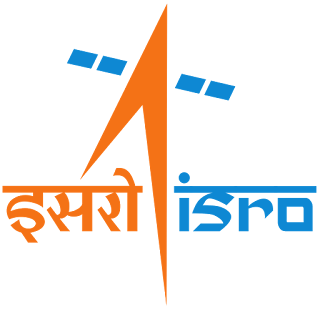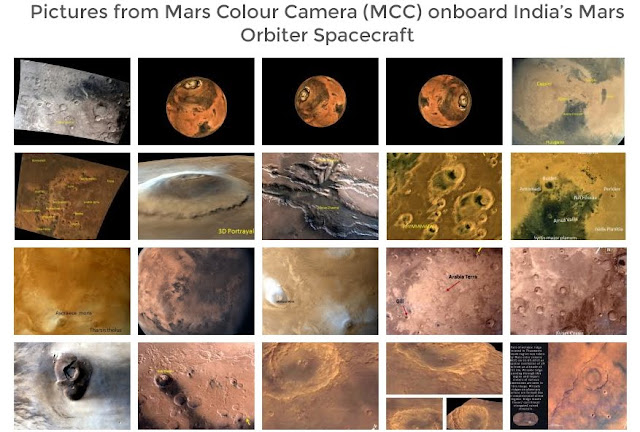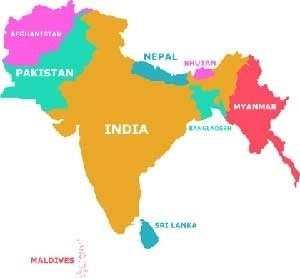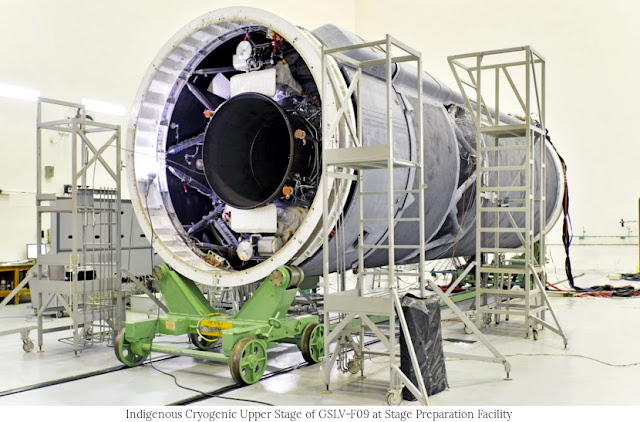At a fraction of the cost of its Western counterparts, India's ISRO is creating history regularly.
Modern India's pride

Modern India has taken great strides in the field of science and technology. Although our notable achievements in all scientific and technological fields like health, agriculture, and defence are exemplary, but in the fields of space, nuclear and missile technologies we have truly excelled.
The Indian Space Research Organisation (ISRO) is India’s premier space research organization. With regular new successful launches, it is adding powerful feathers to its space cap and indicating to the world that Indian space talent is second to none.
ISRO created history on 15-February 2017 by launching 104 satellites in a single launch operation! We cover that at length later (on page 3) in this Bodhi. In May 2017, ISRO also fulfilled the vision of a South Asian satellite, by successfully launching and operationalising the first "South Asian Satellite". Read all about it on page 4 of this Bodhi.
You won't want to miss the amazing selfie video of this historic flight, right? Here it is!
(Total duration : 5:30 min, Original Source here)
[Read this Bodhi in Hindi, here ##link##]
ISRO created history on 15-February 2017 by launching 104 satellites in a single launch operation! We cover that at length later (on page 3) in this Bodhi. In May 2017, ISRO also fulfilled the vision of a South Asian satellite, by successfully launching and operationalising the first "South Asian Satellite". Read all about it on page 4 of this Bodhi.
You won't want to miss the amazing selfie video of this historic flight, right? Here it is!
(Total duration : 5:30 min, Original Source here)
[Read this Bodhi in Hindi, here ##link##]
ISRO was founded in the year 1969 at Bangalore by the Dr. Vikram Sarabhai. Ever since its founding, the agency has been performing wonders using indigenous talent and resources. In fact, a lot of ISRO’s recent work has become part of record books. The Mars Orbiter Mission (Mangalyaan or MoM) reflected this excellence in full glory. MoM was launched on the 28th October 2013, and successfully inserted into the Mars orbit on 24th September 2014.
Mars, here we come!
With the insertion of Mangalyaan into the Mars orbit, ISRO became the world’s first space agency, and India became the first country to do so in the very first attempt! The whole world acknowledged and appreciated India’s effort. Prior to this, ISRO had successfully launched Chandrayaan-1, India's first mission to Moon, on October 22, 2008. The spacecraft was orbiting around the Moon at a height of 100 km from the lunar surface for chemical, mineralogical and photo-geologic mapping of the Moon carrying 11 scientific instruments built in India, USA, UK, Germany, Sweden and Bulgaria. After the successful completion of all the major mission objectives, the orbit was raised to 200 km during May 2009. The satellite made more than 3400 orbits around the moon and the mission was concluded when the communication with the spacecraft was lost on August 29, 2009.
Chandrayaan-2 is in the works already!
 |
| PSLV C 36 with heat shield closed |
 |
| ResourceSat launch - takeoff! |
Continued on Page 2
[next]
Page 2 of 4
Page 2 of 4
Other nations like USA have, since 1970s, sent some satellites into the outer regions of our solar system and on other planets too, and the information gathered in the process has helped mankind make a picture of what the real scale and structure of our solar system really is.
To take the winning streak further, in July 2016, ISRO, through its PSLV – C34, launched 20 satellites in a single shot! This was also the 35th successful mission of PSLV – no mean achievement! The mother of all missions - 104 satellites in one shot - was successfully executed on 15-February, 2017.
Lessons from Kargil - our own eye in the sky
The emerging global security situation necessitated India’s own regional navigation system, to ensure 100% data availability during periods of crisis. Our Kargil GPS experience had proved the downside of relying on systems controlled by other nations. The IRNSS – Indian Regional Navigation Satellite System, or Navik – is now fully functional and offering an unprecedented level of detail to various user groups.
On 26 September 2016, India’s launch vehicle PSLV successfully launched eight satellites, including the country’s SCATSAT – 1 (a miniature satellite to provide weather forecasting, cyclone prediction, and tracking services) and five satellites form other nations in two different orbits. This has ensured that now India has a satellite for almost all purposes – military, weather, telecast and broadcasting, and advanced remote sensing. And the agency does not seem to be resting on its laurels.
The tremendous evolution of technology used for launchers has been a testimony to the grit and determination of Indian scientists, often against not entirely favourable external situations. Today, a stable system of multiple launch vehicles is available.
A strong family
For the inquisitive mind, it can be quite an interesting exercise to take a look at the technical detailing of these launch vehicles, which constitute the most crucial first step in any milestone in space, or military missile launch capabilities.
But ISRO is not resting on its laurels. The steak of entrepreneurial energy and innovation continue unabated as the updates here indicate. Bodhi Booster wishes great success to the pride of India - ISRO!
Continued on Page 3
Indian space operations' workhorse, the Polar Satellite Launch Vehicle (PSLV), in its 39th flight (PSLV-C37) launched the 714 kg Cartosat-2 series satellite for earth observation and 103 co-passenger satellites together weighing about 664 kg at lift-off into a 505 km polar Sun Synchronous Orbit (SSO). PSLV-C37 was launched from the First Launch Pad (FLP) of Satish Dhawan Space Centre (SDSC) SHAR, Sriharikota. It was the sixteenth flight of PSLV in 'XL' configuration (with the use of solid strap-on motors). The co-passenger satellites comprised 101 nano satellites, one each from Israel, Kazakhstan, The Netherlands, Switzerland, United Arab Emirates (UAE) and 96 from United States of America (USA), as well as two Nano satellites from India. The total weight of all the satellites carried onboard PSLV-C37 is about 1378 kg.
PSLV-C37 also carried two ISRO Nano satellites (INS-1A and INS-1B), as co-passenger satellites. These two satellites carry a total of four different payloads from Space Applications Centre (SAC) and Laboratory for Electro Optics Systems (LEOS) of ISRO for conducting various experiments. The 101 International customer Nano satellites are being launched as part of the commercial arrangements between Antrix Corporation Limited (Antrix), a Government of India company under Department of Space (DOS), the commercial arm of ISRO and the International customers. It marks a huge leap forward for Indian aspirations and lay a solid ground for leadership position in global space sweepstakes.
[##star## Bodhi Stars] [##star## Sameeksha Stars] [##star## PT Stars] [##fighter-jet## Free PT Boosters!]
And here's the world's most advanced Selfie Video! Enjoy the rush - Jai Hind!
(Total duration : 5:30 min, Original Source here)
Now we take a look at the first South Asian Satellite - another feather in ISRO's cap!
Continued on Page 4
- [message]
- ##rocket## ISRO - boldly going where no one has gone before!
- The Mangalyaan was made famous by its frugal engineering. But latest reports indicate ISRO did it at even lower than the much-known Rs.450 crore figure - they managed with just Rs.447.3 crores! Recently, Antrix Corporation (the marketing arm of ISRO) adopted the drought-hit Brahmasandra village (Karnataka), as part of its CSR, to help farmers. In 2017, ISRO has plans to launch the SAARC satellite. The remote-sensing mission RESOURCESAT-2A was successfully launched on December 07, 2016 through the PSLV-C36 vehicle. It is a Remote Sensing satellite for resource monitoring, and a follow on mission to RESOURCESAT-1 (2003) and RESOURCESAT-2 (2011). ISRO will launch its heaviest satellite (3.2 tonne GSAT-19E commsat) in January 2017 with GSLV Mk-III rocket. A quick history of GSAT - EARLIER - GSAT-1 (Apr 2001) GSAT-2 (May 2003) GSAT-3 (Sep 2004) GSAT-4 (Apr 2010) GSAT-5P (Dec 2010); ACTIVE NOW - GSAT-8 (May 2011) GSAT-12 (Jul 2011) GSAT-10 (Sep 2012) GSAT-7 (Aug 2013) GSAT-14 (Jan 2014) GSAT-16 (Dec 2014) GSAT-6 (Aug 2015) GSAT-15 (Nov 2015) GSAT-18 (Oct 2016); FUTURE - GSAT-19E (Jan 2017) GSAT-11 (2017) GSAT-17 (2017) GSAT-5 GSAT-6A GSAT-7A GSAT-9 GSAT-13. The mother of all missions was successfully executed on February 15, 2017, when ISRO launched 104 satellites in a single shot.
[next]
Page 3 of 4
Page 3 of 4
A world record of galactic proportions!
(All information and pictures from ISRO website)Indian space operations' workhorse, the Polar Satellite Launch Vehicle (PSLV), in its 39th flight (PSLV-C37) launched the 714 kg Cartosat-2 series satellite for earth observation and 103 co-passenger satellites together weighing about 664 kg at lift-off into a 505 km polar Sun Synchronous Orbit (SSO). PSLV-C37 was launched from the First Launch Pad (FLP) of Satish Dhawan Space Centre (SDSC) SHAR, Sriharikota. It was the sixteenth flight of PSLV in 'XL' configuration (with the use of solid strap-on motors). The co-passenger satellites comprised 101 nano satellites, one each from Israel, Kazakhstan, The Netherlands, Switzerland, United Arab Emirates (UAE) and 96 from United States of America (USA), as well as two Nano satellites from India. The total weight of all the satellites carried onboard PSLV-C37 is about 1378 kg.
PSLV-C37 also carried two ISRO Nano satellites (INS-1A and INS-1B), as co-passenger satellites. These two satellites carry a total of four different payloads from Space Applications Centre (SAC) and Laboratory for Electro Optics Systems (LEOS) of ISRO for conducting various experiments. The 101 International customer Nano satellites are being launched as part of the commercial arrangements between Antrix Corporation Limited (Antrix), a Government of India company under Department of Space (DOS), the commercial arm of ISRO and the International customers. It marks a huge leap forward for Indian aspirations and lay a solid ground for leadership position in global space sweepstakes.
[##star## Bodhi Stars] [##star## Sameeksha Stars] [##star## PT Stars] [##fighter-jet## Free PT Boosters!]
Key Facts of the mega-launch
- India's high resolution Cartosat-2 series satellite was released first into space, and in addition to the multiple civilian applications, is also designed to monitor activities of India's hostile neighbours Pakistan and China, at a very fine resolution! Now that's the power of indigenous technology - lessons from Kargil learnt really well.
- A list of civilian applications is : Cartographic applications, urban and rural applications, coastal land use and regulation, utility management like road network monitoring, water distribution, creation of land use maps, change detection to bring out geographical and manmade features and various other Land Information System (LIS) and Geographical Information System (GIS) applications. That's one long list indeed!
- Cartosat-2 Series, which is the primary satellite, will be similar to the earlier four satellites in Cartosat-2 Series.
- Two Indian nano-satellites - ISRO's INS-1A and INS-1B - carry a total of four different payloads from Space Applications Centre (SAC) and Laboratory for Electro Optics Systems (LEOS) of ISRO for conducting experiments.
- The PSLV first launched the 714 kg CARTOSAT-2 Series satellite for earth observation, followed by 103 co-passenger satellites, together weighing about 664 kg at lift-off into polar Sun Synchronous Orbit, about 520 km from Earth.
- Of 101 co-passenger satellites, 96 belong to USA, five from International customers of ISRO -- Israel, Kazakhstan, Netherlands, Switzerland, United Arab Emirates, respectively.
- The nano-satellites belonging to global customers were launched as part of the arrangement by Antrix Corporation Ltd (ANTRIX) the commercial arm of the ISRO.
104 Friends in Space - the last few hours!
- [message]
- ##rocket## The exciting countdown to 15 Feb, 2017
- ##chevron-right## 15 Feb - ISRO brings glory to the nation yet again! Success built on the foundations of indigenous technology never tasted sweeter!
##chevron-right## 15-Feb - The PSLV-XL variant rocket - 44.4 metre tall and weighing 320 ton - broke free of the Earth's gravitational pull, after lifting off with a huge roar. ISRO has used the same XL Variant - the most powerful rocket - that was earlier used in the ambitious Chandrayaan and during the Mars Mission.
##chevron-right## 15-Feb - Smooth as silk, the trusted workhorse Polar Satellite Launch Vehicle PSLV-C37, on its 39th mission, took off at 9:28 am from Sriharikota space centre with the 104 satellites, of which 101 belongs to international customers.
##chevron-right## 15-Feb - Morning 9:28 am is the Grand launch from SDSC, SHAR! The launch will be closely monitored by ISRO chairman AS Kiran Kumar and other top scientists from the mission control.
##chevron-right## 14 Feb, 2017 - Mobile Service Tower (MST) withdrawal to parking end completed. Preparations for propellant filling operation of Second Stage (PS2) done.
##chevron-right## 14 Feb, 2017 - Mixed Oxides of Nitrogen (MON-3) oxidiser filling operation of PS4 was completed.
##chevron-right## 14 Feb, 2017 - Mono Methyl Hydrazine (MMH) propellant filling operation of fourth stage (PS4) of PSLV-C37 was completed.
##chevron-right## 14 Feb, 2017 - The 28 Hrs countdown activity of PSLV-C37/Cartosat2 Series Satellite Mission started at 05:28 Hrs IST.
##chevron-right## 13 Feb, 2017 - The Mission Readiness Review (MRR) committee and Launch Authorisation Board (LAB) cleared the 28 Hrs countdown of PSLV-C37 Launch.
The big news - India's first mission to Venus (Shukrayaan), and the second to Mars (Mangalyaan 2) - has been finalised and funds allotted by the government. These are slated for 2021-22. A big leap!
The amazing journey in pictures!
 |
| Spacecraft loaded into thermal vacuum chamber |
 |
| PSLV's heat shield being closed with the 104 satellites inside - stay cool! |
 |
| Solar panel illumination test |
 |
| Panel Deployment Test for Cartosat Series 2 satellite |
 |
| Dynamic Balancing Test |
 |
| Cartosat-2 Series satellite |
 |
| Fuel filling of Cartosat-2 Series satellite |
 |
| Vehicle integration - hoisting of the nozzle end of PSLV C-37 |
 |
| Core stage of PSLV C-37 integrated to launch pedestal |
 |
| PSLV C-37 first stage integrated |
 |
| PSLV C-37 liquid stage |
 |
| PSLV C-37 vehicle at mobile service tower |
 |
| PSLV C-37 ready for action! |
 |
| SUCCESS! |
 |
| Blasting off to glory! |
 |
| The sky is not the limit for India, and ISRO! |
 |
| A victory well-deserved! |
And here's the world's most advanced Selfie Video! Enjoy the rush - Jai Hind!
(Total duration : 5:30 min, Original Source here)
Now we take a look at the first South Asian Satellite - another feather in ISRO's cap!
[next]
Page 4 of 4
Page 4 of 4
South Asia gets its own satellite
Enjoy the launch video!
A new era of cooperation can begin with SAARC's SAS
Here is an excerpt from a lecture on Space Technology. Enjoy! More like these here.
Your Comments, Ratings and Reviews are welcome below
Keep our team motivated
[इस बोधि को हिंदी में पढ़ें, यहाँ ##link##]
This Bodhi will be regularly updated. Keep visiting. And do share your thoughts in the Comments thread.
[##star## Bodhi Stars] [##star## Sameeksha Stars] [##star## PT Stars] [##fighter-jet## Free PT Boosters!]
- [message]
- Bodhi Links (for deeper study; Caution: some may be external links, some large PDFs)
- ##chevron-right## IRNSS by ISRO here ##chevron-right## India's Mars Orbiter Mission Mangalyaan here ##chevron-right## ISRO goes to the Moon - Chandrayaan 1 here ##chevron-right## ISRO again seeks the Moon - Chandrayaan 2 here ##chevron-right## About Dr.Vikram Sarabhai here ##chevron-right## NASA homepage here ##chevron-right## Top Space Nations/Agencies of the world here ##chevron-right## Mangalyaan cost less than Rs.450 crores here ##chevron-right## ISRO's Antrix Corp adopts village as CSR here ##chevron-right## ISRO to launch SAARC satellite in 2017 here ##chevron-right## ISRO 2015-16 Annual Report pdf here ##chevron-right## ISRO to launch 104 satellites in one shot! here ##chevron-right## Heaviest launch planned here ##chevron-right## Miniature satellite SCATSAT here
- [message]
- YOUR AFFECTION KEEPS US GOING!
- Spread the good word about Bodhi Booster! Join our social media family using links provided on top right of all pages. Share this Bodhi using the yellow vertical bar icons on right side of your screen. Comment and let us know your views in the Disqus threads. Use हिंदी बोधि and English Bodhis for knowledge development beyond mere exams. Learn English in an easy, spontaneous and practical way - welcome to Bodhi Bhasha. Stay ahead with precise and time-saving news and analysis videos, Shrutis and PDFs by Bodhi News! Use content & expertise of our friends at PT education for competitive exams prep - check their PT Youtube channel, PT site and PT Self-prep courses that help you prepare best right at home!
[Newsletter ##newspaper-o##] [Bodhi Shiksha ##play-circle-o##] [FB ##facebook##] [हिंदी बोधि ##leaf##] [Sameeksha live ##graduation-cap##] [Shrutis ##fa-headphones##] [Quizzes ##question-circle##] [Premium ##rocket##]






















COMMENTS